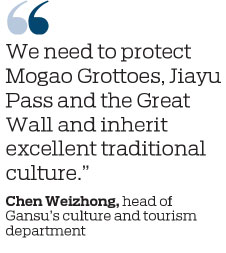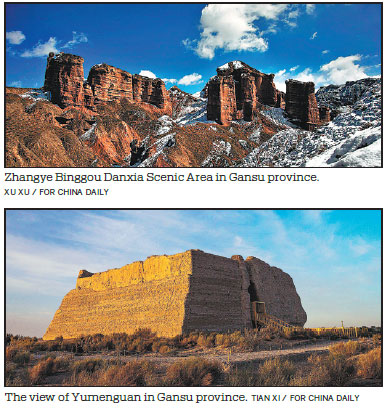Protecting the past key to securing future
Gansu investing in historical sites and beauty spots to attract crowds of visitors
Gansu, a province rich in historical and cultural resources, has promoted cultural tourism in recent years to help benefit the region.
Cultural relics are among the top priorities of the promotion as Gansu highlights the value of the relics in a scientific and well-arranged way, local officials said.
Chen Weizhong, head at Gansu's culture and tourism department, said: "We need to protect Mogao Grottoes, Jiayu Pass and the Great Wall and inherit excellent traditional culture."

Zhao Shengliang, head at the Dunhuang Academy, which manages and studies Mogao, said the institute always puts heritage protection first and uses technology to offer a better visitor experience.
Before entering the caves, visitors can watch documentaries in the Mogao Grottoes' Digital Demonstration Center, to learn about the destination's natural environment, history and cultural background and see digital cave scenes.
After nearly three decades of exploration and practice, the academy has finished the data collection of 206 caves and the three-dimensional scanning of 140 caves and produced virtual roaming programs.
The digital Dunhuang resource library launched its English and Chinese versions globally in 2017.
Jiayu Pass is a famed part of the Great Wall in Jiayuguan city. Local authorities have employed conservators and daily maintenance staff in recent years.
In 2018, the greater Jiayu Pass scenic area received 1.6 million visits.
Zhao Shumin, director at the Jiayuguan city's culture and tourism bureau, said: "We should increase protection and adopt diverse advanced protection technologies."
The bureau should also use cultural heritage to launch unique tour routes and services, Zhao said.
Ecological traveling is another priority in Gansu's tourism development. Shandan Horse Ranch under the Qilian Mountains has focused on ecological protection for years, closing hillsides to aid forestation and return grazing land to grassland.
The horse ranch is on grassland with an elevation of about 2,850 meters and crosses Gansu and Qinghai provinces.
It covers an area of about 219,333 hectares, including more than 125,333 hectares of grassland. On summer days, the vast grassland boasts its most beautiful season, with yellow oilseed rape and a sea of flowers under a blue sky with white clouds. Related authorities have formulated an overall plan for ecological tourism of the horse ranch.
On the banks of the Yellow River in Lanzhou, capital of Gansu, flowers, grasses and trees thrive.
They benefit from a dam-reinforcing project and the environmental improvement of rivers. A pump station has been transformed into a venue for local people to enjoy leisure time.
"Ecology plus culture" traveling has gradually become a powerful driver for economic and social development in many regions in Gansu, local officials said.
In Zhangye city, a wetland museum has opened with an investment of 120 million yuan ($16.71 million).
Meanwhile, a national geological museum with an investment worth 100 million yuan is arranging exhibitions in the city.
Li Zonghai, director at the culture, sports, broadcasting and tourism bureau of Gulang county, said ecological tourism is development trend. The county of Wuwei city will focus on forestation, desertification control and desert tourism.
Gansu is also developing "red tourism", which features visits to sites with significant revolutionary history.
A memorial hall of the West Route Army of the Chinese Workers' and Peasants' Red Army is one such tourism spot.
Huo Ming, office director from the hall, said: "On red culture inheritance, red tourism development and revolution education, we use methods such as sound, images, animation and digital interaction to display revolutionary life and historical sites."
It allows visitors to learn about red culture in interactive participation and make red tourism more attractive, Huo said.
Gaotai county, where the hall is located, will launch tourism services where travelers can be clad in Red Army uniforms, have similar meals the army ate and walk the roads they walked.
|
As an area prioritized for biodiversity conservation in China, the Qilian Mountains are an extremely important landscape for glacier and water conservation.Photos Provided To China Daily |

(China Daily 09/05/2019 page12)















